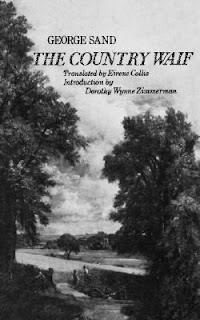Book Review:The Country Waif
by David Blake, Department Head, Fiction Department, Central Library
The Country Waif
Georges Sand
In Swann’s Way Marcel Proust’s grandmother buys The Country Waif for young Marcel because she would not want to give him anything that was not well written. His grandmother was right. George Sand’s writing is extraordinary. The Country Waif reads like a folk tale with edges worn like an old stone memorial tablet, which retains the power to arouse the powerful emotions of a story told by flickering firelight.
Readers of Victor Hugo’s contemporaneous Les Miserables will be familiar with the plight of the thousands and thousands of homeless children in mid-nineteenth century Paris. Homeless children in rural France were waifs, and, like the gamins of Paris, they were despised. The Country Waif is the story of Francois, a waif, and the saintly Madeline, the miller’s wife, who secretly saves him from starvation in a peasant society where even a bowl of soup is missed.
The Country Waif is set in the countryside of Barry, where Sand lived as a child and where she summered with Frederic Chopin during the nine years of their affair. It stimulates the high emotion of its romantic era, and pays convincing respect to the folk writing so prized at the time, but its pastoral realism links it to the later urban realism of Emile Zola.
Like Jane Austen, Georges Sand had to contend with a world that did not take women’s intellectual achievements seriously. Georges Sand is a nom de plume taken on in order to get works published and read. And, like Austen’s novels, The Country Waif is, in part, a story about women, written by a woman, but the reader will be taken by the contrast between Austen’s novels of manners and Sand’s short romantic jewel.
The Country Waif
Georges Sand
In Swann’s Way Marcel Proust’s grandmother buys The Country Waif for young Marcel because she would not want to give him anything that was not well written. His grandmother was right. George Sand’s writing is extraordinary. The Country Waif reads like a folk tale with edges worn like an old stone memorial tablet, which retains the power to arouse the powerful emotions of a story told by flickering firelight.
Readers of Victor Hugo’s contemporaneous Les Miserables will be familiar with the plight of the thousands and thousands of homeless children in mid-nineteenth century Paris. Homeless children in rural France were waifs, and, like the gamins of Paris, they were despised. The Country Waif is the story of Francois, a waif, and the saintly Madeline, the miller’s wife, who secretly saves him from starvation in a peasant society where even a bowl of soup is missed.
The Country Waif is set in the countryside of Barry, where Sand lived as a child and where she summered with Frederic Chopin during the nine years of their affair. It stimulates the high emotion of its romantic era, and pays convincing respect to the folk writing so prized at the time, but its pastoral realism links it to the later urban realism of Emile Zola.
Like Jane Austen, Georges Sand had to contend with a world that did not take women’s intellectual achievements seriously. Georges Sand is a nom de plume taken on in order to get works published and read. And, like Austen’s novels, The Country Waif is, in part, a story about women, written by a woman, but the reader will be taken by the contrast between Austen’s novels of manners and Sand’s short romantic jewel.

Comments